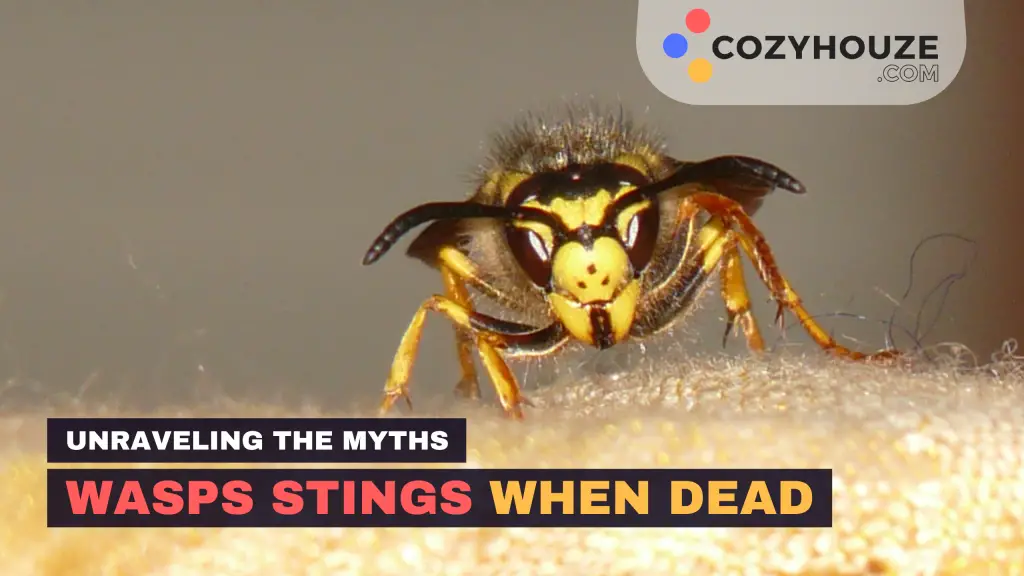When it comes to the enigmatic world of insects, few creatures stir up both curiosity and caution quite like the wasp. These pint-sized powerhouses of nature possess a notorious reputation for their stinging abilities, leaving many to wonder: can wasps sting when dead? It’s a question that tickles our fascination and often fuels myths and misconceptions. In this comprehensive article, we’re delving deep into the world of wasps, their anatomy, behavior, and the truth behind whether they can deliver a sting from beyond the grave.
Unveiling the Mysteries of Wasps
Wasps, those resilient architects of intricate nests and possessors of painful stings, belong to the Hymenoptera order, which includes bees and ants as well. Their presence ranges from being pesky picnic crashers to essential pollinators. However, it’s their ability to deliver potent stings that has cultivated fear and intrigue. The question of whether wasps can sting posthumously is a fascinating avenue to explore.
The Anatomy of a Wasp’s Sting
Before we address the question at hand, it’s imperative to understand the mechanics of a wasp’s sting. Armed with a venomous apparatus located at the rear end of their abdomen, wasps use their stingers as both a weapon and a tool for hunting and defense. This stinger is connected to venom glands, which inject a cocktail of chemicals that can trigger pain and allergic reactions in some individuals.
Stinging: A Defensive Mechanism
Wasps primarily employ their stingers as a defense mechanism. When threatened or provoked, they release venom to deter predators or perceived threats. This prompts the question: can wasps activate this defense even when deceased?
Myth Busting: Can Wasps Sting When Dead?
The idea of a deceased wasp still possessing the ability to sting seems like a plot straight out of a science fiction movie. However, reality paints a different picture. Once a wasp dies, its bodily functions cease, including the ability to actively sting. The act of stinging requires a live wasp to control its muscular and neural systems, which is impossible after death.
Decoding Wasp Behavior After Death
Understanding the behavior of wasps after they meet their demise further solidifies the notion that they cannot sting in death. Unlike some other insects, wasps do not exhibit any coordinated post-mortem actions. They do not have the capacity to control their movements or reactions once life has left their tiny bodies.
The Wasp’s Sting: A One-Time Feature
The mechanics of a wasp’s sting further reinforce the fact that they cannot sting when dead. The stinger itself is a complex structure that is not designed for repeated use. When a live wasp stings, the barbed stinger becomes lodged in the target’s skin, often leading to the wasp’s own demise as it tears away from the wasp’s body. This mechanism serves as a one-time, self-sacrificing act.
FAQs About Wasp Stinging Abilities
Can a wasp sting multiple times in its lifetime?
No, a wasp can only sting once. The stinging mechanism is fatal to the wasp, as it leads to its death.
Are all wasp stings equally painful?
The severity of a wasp sting’s pain varies depending on factors such as the wasp’s species, the individual’s pain threshold, and potential allergies.
Can a dead wasp’s stinger be used as a weapon?
No, the stinger detaches from the wasp’s body upon stinging, rendering it useless for any purpose once the wasp is deceased.
Do wasps always die after stinging?
Yes, the stinger’s detachment from the wasp’s body during stinging causes severe injury and often leads to the wasp’s death.
How can I avoid getting stung by a live wasp?
To minimize the risk of getting stung, avoid sudden movements around wasps, wear light-colored clothing, and refrain from wearing scented products.
Are all wasps aggressive?
No, not all wasp species are aggressive. Some are more docile and less likely to sting unless provoked.
Conclusion: Dispelling the Myth
In the world of insects, myths often sprout alongside genuine curiosity. The notion that a dead wasp can continue to sting is a prime example of how misinformation can take root. Through understanding the intricate mechanisms of a wasp’s anatomy and behavior, we can confidently debunk this myth. A wasp’s sting is an exclusive feature of its living state, relying on its ability to manipulate its bodily functions.
So, the next time you encounter a lifeless wasp, you can put to rest any concerns about a posthumous sting. As we continue to explore the hidden intricacies of the natural world, let this serve as a reminder that even the most tenacious myths can be unraveled with a touch of scientific inquiry.


